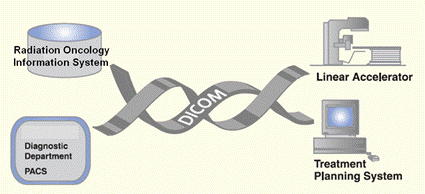OIS and Treatment & verify systems
A record and verify system (RVS) is a software application at the treatment console that confirms the treatment parameters set on the treatment unit match those of the treatment plan and provides an electronic record of treatment. RVS software has evolved into a more comprehensive software application, the oncology information system (OIS). The OIS is a software application that manages the flow and storage of electronic information, including patient data, in the radiotherapy department. These are essential components of a radiotherapy program and should be considered in the planning phase.
To function as intended, the RVS must have stored a complete set of information, including the patient’s identification, prescription, treatment plan and field parameters, and must allow this information to be entered and called up correctly for each treatment. The RVS must also contain details about the treatment equipment, including the coordinate, scale and angle conventions used, beam energies, available field sizes and other parameters and limitations. When these parameters are incorrectly entered in the RVS, systematic treatment errors will occur.
The OIS performs not only the functions of the RVS but can also transfer treatment plan information and reference images from the TPS to the treatment unit, record detailed dose delivery information and images for each treatment session, include an image review module, manage the patient care pathway, include an electronic patient record and manage staff workflow through defined tasks, treatment unit schedules and appointments. The OIS uses standard protocols for data transfer of radiotherapy specific electronic information. The OIS may also connect to the hospitals information system using the Health Level Seven International (HL7) standard or equivalent and connect to a radiology PACS system for image transfer. More information about the technical specifications for an OIS can be found in the WHO/IAEA document, “technical specifications of radiotherapy equipment for cancer treatment”.
The RVS and OIS need to be seamlessly integrated with the treatment units and the TPSs. Additional OIS functionality including image review, clinical assessment, dosimetry records, scheduling of activities and alerts, and electronic patient records and appointments need to be considered.
Implementation of an OIS will require large amounts of electronic data storage of patient information, including images, treatment plans and records of treatment delivery. Redundancy and back-up procedures should be in place to minimize the risks of electronic information loss in the event of server or computer failure. The radiotherapy department needs to engage information technology professionals to maintain the security and integrity of electronic data to prevent its unauthorized disclosure or modification that may compromise the radiotherapy process. The radiation oncology department should also implement procedures to prevent hacking and data corruption.
The procedure for acceptance testing of the OIS, including its RVS functions, should be similar to that of other equipment used in a radiotherapy department. After its installation in a hospital, the user should perform a series of tests, jointly with the vendor, to verify if the system performs according to its specifications. A thorough commissioning of the OIS, including its RVS functions, should follow the acceptance before they can be used clinically. Information about the acceptance tests and commissioning process that should be used in conjunction with the installation of a new RVS can be found in the IAEA Human Health Reports No. 7.
In addition, an ongoing quality control programme must be devised to prevent any drift in its performance. Of particular importance are checks of uncorrupted flow of information between the TPS and treatment units. Upgrades and updates of the OIS software need to be managed to ensure no loss of patient data, no compromise of information and computer security and no loss of expected performance



